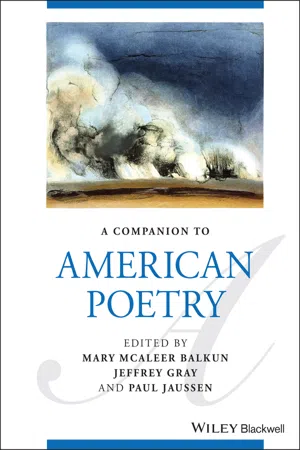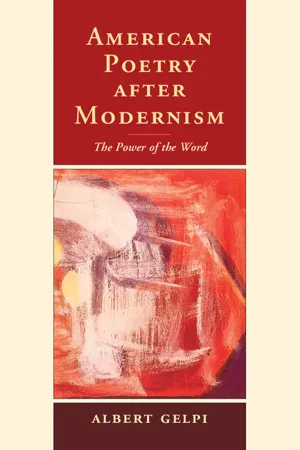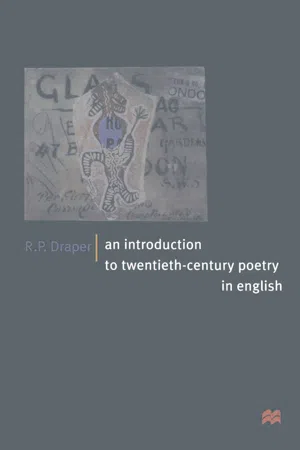Literature
Black Mountain Poets
The Black Mountain Poets were a group of avant-garde poets associated with Black Mountain College in North Carolina during the 1950s and 1960s. They emphasized experimentation, collaboration, and interdisciplinary approaches to poetry, often incorporating visual and performative elements into their work. Notable members included Charles Olson, Robert Creeley, and Denise Levertov. Their work had a significant influence on the development of modern American poetry.
Written by Perlego with AI-assistance
Related key terms
1 of 5
5 Key excerpts on "Black Mountain Poets"
- eBook - PDF
- Eleanor Spencer-Regan(Author)
- 2017(Publication Date)
- Red Globe Press(Publisher)
In The New Poetry edited by Al Alvarez, for example, a prominent British anthology from the same era, the two American ‘confessional’ poets Robert Lowell and John Berryman are held up as something of an example for British poets to follow. 12 This is partly as 210 Rory Waterman a result of Alvarez’s polemical introduction, and partly because he puts these two Americans at the front of the book, before a slew of British poets, in what was otherwise a British anthology. Though it is far less ostensibly judgemental, however – between the poets it includes, at least – Allen’s anthology does favour the more established for the sim-ple reason that they tend to be the oldest and the oldest go first. More to the point, he has to begin the book somewhere, with the poets of one of his five categories, and opts for those poets associated with Black Mountain College in North Carolina, where Olson, Creeley and others had taught (but which had closed in 1956). It is a decision that makes some sense, in that the Black Mountain Poets were perhaps the central of Allen’s four groups, with clear links to the Beats and San Francisco poets. This was partly due to the efforts of Creeley, who had edited Black Mountain Review for two years, publishing several of the Beat poets before moving to San Francisco in 1957. But it was also partly due to the overwhelming influence on modernist poetry of Olson’s essay ‘Projective Verse’, first published in 1950. This advocated ‘open field’ poetic composition, in which each line is predicated on the breath and the single utterance, and each perception immediately and directly is followed by the next perception. ‘Projective Verse’ effectively became a manifesto for the poets directly or tangentially associated with the Black Mountain College, and also influenced poets as ostensibly different from Olson as Ginsberg. - eBook - PDF
- Mary McAleer Balkun, Jeffrey Gray, Paul Jaussen, Mary McAleer Balkun, Jeffrey H. Gray, Paul Jaussen, Mary McAleer Balkun, Jeffrey H. Gray, Paul Jaussen(Authors)
- 2022(Publication Date)
- Wiley-Blackwell(Publisher)
This final issue drew the San Francisco Renaissance and the Beat Generation into the collective efforts of The Black Mountain Review , publishing Allen Ginsberg, Jack Kerouac, William Burroughs, Michael McClure, Gary Snyder, and others. Further, the reviews display the internal disa-greements that shaped The New American Poetry . Issue #7 includes Ginsberg’s poem, “America: Part II,” and a critical review of Ginsberg’s “Howl” by Olson’s Black Mountain student, Michael Rumaker, whose raw stories “The Truck” and “The Pipe” had appeared in previous issues. In his review, Rumaker suggests that Ginsberg’s anger is detrimental to poetry’s vitality, supplying the impetus for dividing the Black Mountain Poets from the Beat Generation, a clear division that Allen reproduced in The New American Poetry . After arguing that the great talent and energy of the Beat Generation required cultivation, he concludes that Black Mountain College would have been the perfect ground: Some asylum needed, where the handful possessing such capabilities gather, to be private, each to himself, to let this frail thing germinate. Black Mountain College closed its doors—everything there, equipped, ready, willing —no money. Nobody who had it interested enough, daring, aware enough, generous. Shous [sic] regard for education in America: i.e. the inquisitive, the curious, the experimental and adventurous spirit, not wanted. (Creeley 1969, p. 234) 144 A Companion to American Poetry Lambasting how American culture destroys the creative spirit that is inquisitive and experimen-tal, Rumaker’s critique terminates as an elegy for Black Mountain College. - eBook - PDF
American Poetry after Modernism
The Power of the Word
- Albert Gelpi(Author)
- 2015(Publication Date)
- Cambridge University Press(Publisher)
The four of them were scattered across the map – Olson in Gloucester as well as Black Mountain, Creeley in Mallorca and New Mexico, Duncan in San Francisco, Levertov in New York – but they were connected by a crisscrossing web of friendships and correspon- dences. Through Olson, Duncan and Creeley had residences at Black Mountain; Levertov never went to the college and met Olson only later at a conference, but Creeley and Duncan are her link to Black Mountain The Language of Vision 167 poetics. In the poetry wars of the postwar decades the Beats and the Black Mountain Poets represented experimental open form against the closed forms of Richard Wilbur, James Merrill, and J. V. Cunningham. But where the Beats drew their inspiration from Whitman’s free verse and from jazz and blues, the Black Mountain Poets coalesced around Olson’s 1950 essay “Projective Verse,” which in turn took as its point of departure not the Romantic Whitman but the Modernist experimentation of Pound and Williams in the first half of the century and of their Objectivist suc- cessors Louis Zukofsky and George Oppen. “Projective Verse” headlined its theory of open form, in Olson’s emphatic caps, as “COMPOSITION BY FIELD.” The linguistic field of the poem followed and enacted the poet’s engagement with the multidi- mensional field of experience. The lines of the poem were shorn of the initial caps that set them off as scanable metrical units and orchestrated themselves across the space of the page through linebreaks and indented left-hand margins, so that the spatial arrangement, like a musical score, registered the temporal measure of the lines through the field of the poem. - R.P. Draper(Author)
- 1999(Publication Date)
- Bloomsbury Academic(Publisher)
7‘Black Mountain’, and the Poetry of D. H. Lawrence and Ted Hughes PROJECTIVE VERSEIn the 1940s the American poet Charles Olson (1910–1970) became the rector of Black Mountain College, a liberal institution in the western part of the state of North Carolina. The College’s aims included the development, both in theory and practice, of a free and informal (but not formless) style of poetry dubbed ‘projective verse’. In his essay on this subject Olson deplores what he sees as ‘the reaction now afoot [i.e. in 1950] to return verse to inherited forms of cadence and rime’; and, harking back to the work of Ezra Pound and William Carlos Williams, he argues for a more ‘open verse’ which will be responsive to the ebb and flow of emergent meaning. It will not be a verse of orderly shaping and monumental solidity, but a lithe, flexible and energetic verse capable of picking up intimations of the future rather than enshrining ideas and emotions of the past. Instead of accentual metre and rhyme Olson promotes a new technique in which syllables and lines are governed purely by the sensitivity of the poet’s ear, and in which there is an instinctive appreciation of the relation between phrasing and breath comparable to that of a good actor or musical performer. (Although he makes no actual reference to the speaking of verse, Olson was a dramatist as well as a poet; and, still more to the point, he was also a trained musician.)Olson also sees projective verse as part of a necessary corrective to the arrogance of modern man whose technology has substituted machinery and mechanical repetition for the supple rhythms of nature. Thus traditional metric is associated in his mind with assertion of the ego – ‘that peculiar presumption by which western man has interposed himself between what he is as a creature ... and those other creations of nature which we may, with no derogation call objects’. Projective verse is to be free from this egotism. It springs from a proper understanding of man’s relation to nature, which Olson defines as ‘that force to which [man] owes his somewhat small existence’, and instead of using ‘artificial forms’ it allows shapes to ‘make their own way’. Nevertheless, although organic form and organic development are its preferred means, one modern mechanical invention is an asset to projective verse – the typewriter:- eBook - PDF
- Christopher MacGowan(Author)
- 2008(Publication Date)
- Wiley-Blackwell(Publisher)
In addition, it gave the first national exposure to a number of emerging writers. Allen was assisted in his selection and planning, as he acknowledged, by Charles Olson. Olson was a tireless theorizer of open, organic form, and for a time principal of the radical Black Mountain College. The poets associated with the school and/or its journal, including Olson himself, Robert Creeley, Robert Duncan, and Denise Levertov, formed one of Allen’s groupings. Olson’s essay “Projective Verse” was an important statement of their principles (in a gesture that recognized some of the continuities, William Carlos Williams had quoted from it and discussed it in his 1951 Autobiography ). Another of Allen’s groups was the Beat writers, most notably Allen Ginsberg, whose reading and sub-sequent publication of “Howl” made him first a local then a national celebrity almost overnight. The San Francisco poets, most of whose work as individuals was not sustained in future years but who represented an important center for contemporary writing that had arisen in the early 1950s, formed another group. Writers associated with New York, including John Ashbery and Frank O’Hara, writing verse that was urban, sophisticated, and concerned with the moment, formed another. In a miscellaneous group for which Allen claimed no common characteristic he included LeRoi Jones, later, as Amiri Baraka, to be a central figure in the protest voice of the Black Arts movement. To varying degrees Allen’s poets set themselves against the prevailing political conservatism of the United States in the 1950s, arguing overtly or implicitly for a different set of values to those associated with the suburban, materialistic lifestyle produced by America’s post-war wealth, and fore-grounded in the growing medium of television and by the popular magazines of the day.
Index pages curate the most relevant extracts from our library of academic textbooks. They’ve been created using an in-house natural language model (NLM), each adding context and meaning to key research topics.




